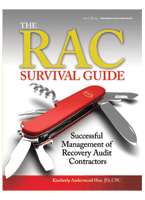RAC ALERT
NEW RAC STATEMENT OF WORK
Are you up to date on the New RAC Statement of Work? Let’s discuss the details.

Vickie Axsom-Brown, Senior Consultant, BHM Healthcare Solutions
Recently, a Centers for Medicare & Medicaid Services (CMS) Cms.hhs.gov- Recovery Audit Contractor Update was generated. The new update was the 090111 Recovery Audit Program Final SOW
[PDF, 292 KB] (an updated State of Work for the Recovery Auditors). The following areas were updated:
- Page 1 – Recovery Audit Contractor Program changed to Recovery Audit Program with contractors called “Recovery Auditors.”
- Page 1 – Addition – “The CMS expects Recovery Auditors to review all claim types to assist the Agency in lowering the error rate and in identifying improper payments that have the greatest impact on the Trust Fund.”
- Page 1 – Addition – “…review of all claim and provider types and a review of claims/providers that have a high propensity for error based on the CERT program and other CMS analysis.”
- Page 6 – Addition (collaboration for program improvements) – “The Recovery Auditors will identify and report LCDs that can benefit from central office evaluation and identify their characteristics (out of date, technically flawed, ambiguous, and/or superficial). Identification of these LCDs will improve the integrity of the Medicare program and the performance of the Recovery Auditor program.”
- Page 7 – Additional clarification to address large organizations who have multi-sited locations across Recovery Auditors – “Unless otherwise directed by CMS through technical direction, the claims being analyzed for this award will be all fee-for-service claims processed in Region ___ regardless of the providers’ or suppliers’ physical locations. Exception: Claims processed by the legacy fiscal intermediary Wisconsin Physician Services (WPS) will be subject to review exclusively by the Recovery Auditor with jurisdiction over the provider’s physical location.”
- Pages 8-9 Improper Payments INCLUDED in the State of Work include the list of provider types to eliminate misunderstandings. Medicaid RAC documents have referred to Medicare Recovery Auditor focus limitations as acute care facilities. [i]
- Page 20 – New Review Type – “Through ‘semi-automated review’ which entails an automated review using claims data and potential human review of a medical record or other documentation.”
- Page 22 – “Semi-Automated Review is a two-part review. The first part is the identification of a billing aberrancy through an automated review using claims data. This aberrancy has high indexes of suspicion to be an improper payment. The second part includes a Notification Letter that is sent to the provider explaining the potential billing error that is identified. The letter also indicates that the provider has 45 days to submit documentation to support the original billing. If the provider decides not to submit documentation, or if the documentation provided does not support the way the claim was billed, the claim will be sent to the Medicare claims processing contractor for adjustment and a demand letter will be issued. However, if the submitted documentation does support the billing of the claim, the claim will not be sent for adjustment and the provider will be notified that the review has been closed. This type of review is to be used in which a clear CMS policy does not exist but in most instances the items and services as billed would be clinically unlikely or not consistent with evidence-based medical literature.
- Page 22 – “The Recovery Auditor is not required to reimburse providers for the additional documentation submitted for semi-automated reviews.”
- Page 23 – Section Addition – “DRG Validation vs. Clinical Validation – DRG Validation is the process of reviewing physician documentation and determining whether the correct codes, and sequencing were applied to the billing of the claim; Clinical validation is a separate process, which involves a clinical review of the case to see whether or not the patient truly possesses the conditions that were documented.





